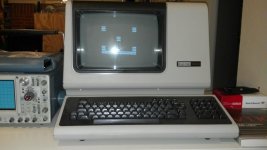Xezlec
Member
Dear fellow retronauts,
I have quite a tale of woe.
I bought a VT102 advertised as "new in box" on eBay. It was very nearly that. I've never seen such an old device in such flawless condition. Baud rates above 4096 didn't seem to work for some reason (may have just been my setup) but otherwise 100%, with manuals and everything! I was very excited to have obtained possibly the last near-mint-condition VT102 on Earth.
After using it for a few days, there was a thunderstorm. One lightning bolt that night was so loud I thought it must have hit my apartment directly. Despite having everything in my apartment plugged into expensive surge protectors, and despite having everything but the cable modem turned off at the time, and despite there being fuses in the power supplies, I discovered the next morning that my cable modem, my PC, and by far worst of all, my VT102, lay in ruin.
Having been proud to be preserving such a lovely piece of computing history, you can imagine my agony at the realization that I had done precisely the opposite. It took me a while to go back to it.
When I turn it on, I smell the distinct aroma of roast resistor, but I don't see any components visibly blackened inside. The screen doesn't seem to be capable of forming a stable pattern anymore, though it tries. Based on keyboard lights, it appears possible that the logic board is OK. (What are the chances?)
My questions are two:
1. Do I have a snowball's chance in the core of a neutron star of getting it working again?
2. Where do I start?
Thanks for any help. I can assure you that from now on, everything I own gets unplugged whenever there is even a chance of a storm.
I have quite a tale of woe.
I bought a VT102 advertised as "new in box" on eBay. It was very nearly that. I've never seen such an old device in such flawless condition. Baud rates above 4096 didn't seem to work for some reason (may have just been my setup) but otherwise 100%, with manuals and everything! I was very excited to have obtained possibly the last near-mint-condition VT102 on Earth.
After using it for a few days, there was a thunderstorm. One lightning bolt that night was so loud I thought it must have hit my apartment directly. Despite having everything in my apartment plugged into expensive surge protectors, and despite having everything but the cable modem turned off at the time, and despite there being fuses in the power supplies, I discovered the next morning that my cable modem, my PC, and by far worst of all, my VT102, lay in ruin.
Having been proud to be preserving such a lovely piece of computing history, you can imagine my agony at the realization that I had done precisely the opposite. It took me a while to go back to it.
When I turn it on, I smell the distinct aroma of roast resistor, but I don't see any components visibly blackened inside. The screen doesn't seem to be capable of forming a stable pattern anymore, though it tries. Based on keyboard lights, it appears possible that the logic board is OK. (What are the chances?)
My questions are two:
1. Do I have a snowball's chance in the core of a neutron star of getting it working again?
2. Where do I start?
Thanks for any help. I can assure you that from now on, everything I own gets unplugged whenever there is even a chance of a storm.

